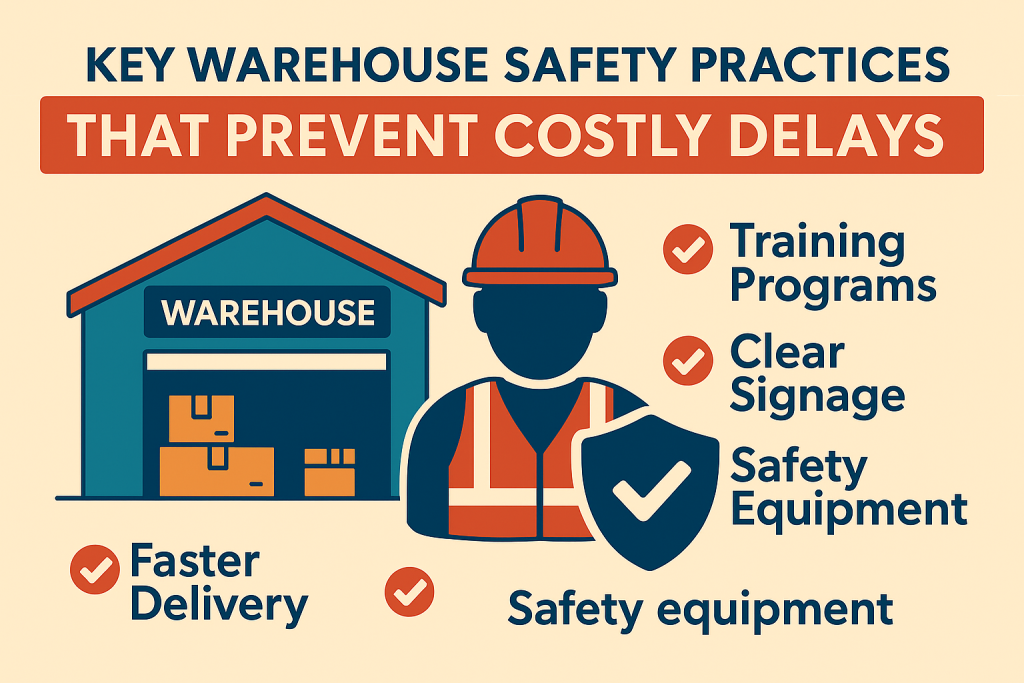By Martin Vassilev / 16 Aug, 2025

Efficient and safe warehouse operations are the backbone of any successful logistics and supply chain strategy. While speed and cost efficiency are critical, workplace safety remains the most important factor that ensures uninterrupted operations, reduces liability, and prevents costly delays. A single accident, equipment breakdown, or safety violation can halt your workflow, increase insurance costs, and damage client trust.
In this guide, we explore the most critical warehouse safety practices that protect workers, safeguard inventory, and keep operations running on schedule. These best practices are rooted in modern logistics standards, regulatory compliance, and proven operational strategies that leading companies apply to maintain a competitive edge.
Warehouse safety is not just about protecting employees—it’s about safeguarding the entire supply chain. An unsafe environment can result in:
Workplace Injuries: Which lead to lost workdays, compensation claims, and reduced productivity.
Equipment Downtime: Damaged machinery can disrupt fulfillment schedules.
Regulatory Fines: Failure to comply with safety regulations can result in hefty penalties.
Inventory Damage: Improper handling or unsafe conditions increase product loss.
Client Dissatisfaction: Delays can lead to broken contracts and a damaged reputation.
By integrating safety into every aspect of operations, companies can reduce risks while improving workflow efficiency.
For example, advanced solutions such as smart warehouse automation now combine AI and safety monitoring to streamline processes while preventing hazards.
Every new hire should receive thorough safety orientation before handling equipment or working on the floor. This includes:
Familiarization with warehouse layout and emergency exits.
Instruction on proper use of personal protective equipment (PPE).
Training on hazard identification and reporting.
Safety training should be ongoing, not a one-time event. Refresher courses, safety drills, and updated hazard training help keep employees aware of evolving risks.
Internal tip: Many companies pair training with technology, such as real-time warehouse tracking systems, to ensure accountability and improve safety compliance.
Well-maintained equipment not only operates more efficiently but also prevents accidents. This includes:
Forklifts and Pallet Jacks: Operators should be licensed and certified.
Conveyor Belts: Regular inspections to prevent jams and mechanical failures.
Automated Systems: Preventive maintenance schedules to reduce downtime.
Regular servicing also minimizes costly breakdowns, ensuring operations stay on track. For instance, companies using AI-powered warehouse systems can detect potential issues before they cause accidents or slowdowns.
Separate pedestrian walkways from forklift and vehicle lanes with bright markings, barriers, or overhead signs.
Heavy items stored at waist level to prevent strain injuries.
Flammable materials stored in designated fire-resistant areas.
Clear labeling to prevent mishandling of hazardous goods.
Efficient layout design not only improves safety but also enhances workflow efficiency. Following lean warehousing principles can reduce unnecessary movement, minimize hazards, and speed up operations.
Safety managers should conduct regular inspections to detect:
Damaged shelving or racking systems.
Loose electrical wiring.
Slippery or obstructed pathways.
Poorly lit areas.
Warehouses that adopt proactive hazard monitoring see significant reductions in delays caused by accidents and shutdowns. The implementation of IoT-based sensors allows for instant alerts when unsafe conditions arise.
Install fire suppression systems in all storage and loading areas.
Keep fire exits accessible and unobstructed.
Store combustible materials safely.
Conduct regular evacuation and emergency response drills to ensure employees react quickly during crises. This helps avoid panic and reduces downtime in the event of real emergencies.
According to Occupational Safety and Health Administration (OSHA) guidelines (source), fire safety compliance is essential not only for legal reasons but for protecting assets and preventing extended shutdowns.
Musculoskeletal injuries from improper lifting are among the most common warehouse incidents. Training should include:
Bending knees instead of the back.
Using mechanical aids when handling heavy items.
Team lifting for oversized loads.
By reducing injury risks, businesses also avoid the productivity losses that come from worker downtime.
Technological solutions now play a key role in warehouse safety, including:
Wearable Safety Devices: Alert workers if they enter restricted zones.
CCTV and AI Surveillance: Detect unsafe behaviors in real time.
Automated Alerts: Warn staff of incoming machinery or environmental hazards.
These solutions help eliminate human error and allow managers to intervene before incidents occur.
Accurate inventory control ensures that hazardous materials, oversized products, and fragile goods are handled correctly. Implementing real-time inventory updates reduces clutter, improves traffic flow, and ensures the right products are stored in the safest locations.
You can explore more on reducing operational risks in The Hidden Costs of Poor Warehousing Management.
Warehouses must comply with both local and international safety regulations, such as:
OSHA Standards (U.S.)
Canadian Centre for Occupational Health and Safety (CCOHS) Guidelines (source)
ISO 45001 Occupational Health and Safety Standards
Compliance ensures operational continuity and protects against costly legal action.
Regular audits should track:
Number of incidents per quarter.
Equipment inspection compliance.
Employee adherence to safety protocols.
Management should use data analytics to identify recurring risks and implement corrective measures.
In fact, using data analytics in warehouse safety can significantly reduce downtime, as outlined in How to Leverage Data Analytics for Streamlined Inventory Management.
Warehouse safety is more than compliance—it’s a business strategy. Preventing costly delays through proactive safety measures enhances customer satisfaction, reduces operational costs, and strengthens brand trust. Companies that integrate safety into their culture and technology stand out in the competitive logistics market.
For businesses seeking expert solutions that combine efficiency and safety, contact ByExpress today to optimize your warehouse operations without compromising on worker well-being.

“Thanks to Byexpress all my shipping and fulfillment costs are in line now”

“All my issues were solved by Byexpress team that I had with pervious 3pl provider.”

“Thank you Byexpress team could not done it without you guys.”

“Their integration and customer service were the key for me”

“Outstanding delivery service! The package was well-packaged, and
the delivery team was professional and courteous”

“Great and knowledgeable team to work with.”

Thanks, guys, for reducing my shipping rates
Ottawa Office
2411 Holly Lane
Ottawa, ON, K1V 7P2
Toronto Office
13-280 West Beaver Creek Road Unit #136
Richmond Hill, ON, L4B 3Z1
Alexandria Office
173 Kenyon Street West
Alexandria, ON, K0C 1A0
Montreal Office
4388 Saint-Denis Street Unit #200
Montreal, QC, H2J 2L1
California Office
155 North Riverview Drive
Anaheim Hills, CA, 92808
Call Us
Toll-Free: 1-866-744-7122
Local : 613-739-3000
Email Us
Multilingual Services










